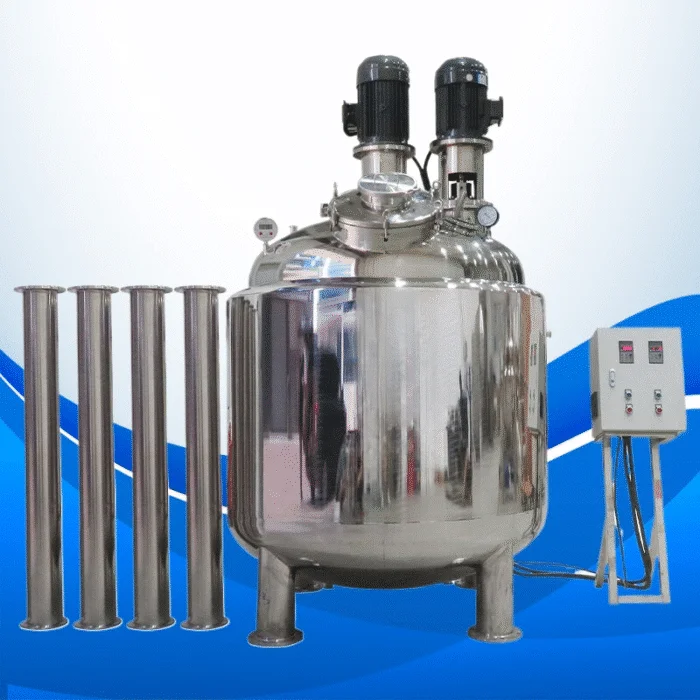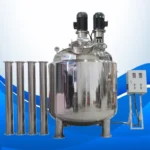In the manufacturing world, efficiency, precision, and quality are paramount. Whether you’re producing food, beverages, chemicals, or pharmaceuticals, having the right equipment can make a world of difference. One essential piece of equipment in many industries is the Jacket Mixing Tank. This versatile tool helps ensure that your products are mixed and heated to the perfect consistency. But with so many options available, how do you choose the right one for your manufacturing needs?
What Is a Jacket Mixing Tank?
A Jacket Mixing Tank is a specialized tank that combines mixing and heating in one system. It has an outer jacket that can be heated or cooled, providing precise temperature control during the mixing process. This feature is essential for industries where temperature plays a crucial role in product quality, such as food and beverage production, pharmaceuticals, or chemicals.
The mixing mechanism inside the tank ensures that ingredients are blended thoroughly, while the heating jacket keeps the contents at the desired temperature. Whether you’re producing a batch of sauces, creams, or chemical solutions, this tank is designed to improve both the consistency and quality of your products.
Assessing Your Manufacturing Requirements
Before purchasing a Jacket Mixing Tank, it’s important to assess your specific manufacturing needs. Consider the type of products you are making and the volume of production required. For example, a small-scale bakery might need a different tank than a large beverage factory. The right tank should align with your production capacity, process requirements, and desired product characteristics.
One of the first things to consider is the tank’s size. A larger tank is ideal for high-volume production, but if you’re dealing with smaller batches or a diverse product range, a smaller, more flexible tank might be a better fit. Knowing your expected batch sizes and processing speeds will guide you in choosing a tank with the correct specifications.
Temperature Control: An Essential Factor
Temperature control is a key feature of a Jacket Mixing Tank. Certain products require precise temperature regulation to achieve the correct texture, consistency, or chemical reaction. In the food industry, for example, maintaining the proper temperature during mixing is crucial for preventing overcooking or undercooking of ingredients.
When selecting a tank, pay close attention to the heating capabilities. The jacket should be designed to provide uniform heat distribution, thereby avoiding hot spots or uneven mixing. Some tanks come with advanced features, such as adjustable heating settings or digital controls, allowing you to fine-tune the temperature for various production processes.
Additionally, some Jacket Mixing Tanks offer the ability to cool products as well. This feature can be essential for cooling products like sauces or creams to the right temperature before packaging. If your manufacturing process requires both heating and cooling, look for a tank that can efficiently handle both tasks.
Mixing Efficiency and Mechanisms
Another critical factor when choosing a Jacket Mixing Tank is the type of mixing mechanism inside the tank. Different products require different mixing styles. For example, if you’re working with thick pastes or heavy creams, you’ll need a more powerful mixing system to ensure proper blending.
There are several types of mixing mechanisms, including impeller mixers, anchor mixers, and turbine mixers. Each has its benefits, depending on the type of product being processed. Impeller mixers are great for liquids and low-viscosity products, while anchor mixers are ideal for thicker materials. Understanding the viscosity of the materials you’re working with will help you choose the appropriate mixing mechanism for your Jacket Mixing Tank.
The mixer’s speed and the ability to adjust it are also essential factors to consider. Some tanks offer variable speed options, allowing you to customise the mixing speed for different stages of production. This flexibility is vital to creating consistent products, especially when you have varying recipes or ingredients.
Material of Construction
The material of the Jacket Mixing Tank is crucial to its durability, safety, and ease of cleaning. In the food and beverage industry, for instance, hygiene is a top priority, so the tank must be made of materials that are resistant to corrosion and easy to clean. Stainless steel is the most common material used for these tanks due to its resistance to rust, easy maintenance, and ability to withstand high temperatures.
When selecting a Jacket Mixing Tank, make sure the material aligns with the requirements of your industry. For example, if you’re working with chemicals or pharmaceuticals, you may need a tank made from materials that are resistant to specific substances. It’s also important to check that the material is FDA-approved or compliant with relevant industry standards, especially in food and beverage manufacturing.
Energy Efficiency and Cost-Effectiveness
Energy efficiency is an important consideration when choosing a Jacket Mixing Tank. Manufacturing processes can be energy-intensive, so selecting a tank that minimizes energy consumption while maintaining performance is crucial for both cost-effectiveness and sustainability.
Look for Jacket Mixing Tanks with energy-efficient heating systems, such as those that use advanced insulation to minimize heat loss or those that offer precise temperature control. By reducing energy consumption, these tanks not only help lower your operating costs but also contribute to a more eco-friendly production process.
Additionally, consider the overall cost-effectiveness of the tank. While it’s tempting to opt for the cheapest option, investing in a high-quality, durable tank will pay off in the long run. A well-built tank can last for many years, reducing the need for frequent repairs or replacements.
Maintenance and Durability
Proper maintenance is essential for ensuring the long-term performance of your Jacket Mixing Tank. Look for a tank that is easy to maintain and clean. Stainless steel tanks, for example, are highly durable and resistant to damage, but it’s still important to follow the manufacturer’s guidelines for maintenance.
Check whether the tank requires regular inspection of the mixing mechanism, heating jacket, and other components. Some manufacturers offer maintenance services or warranties that can help ensure the continued functionality of your equipment.
Conclusion
Choosing the right Jacket Mixing Tank for your manufacturing needs is a critical decision that can impact the quality and efficiency of your production process. By considering factors such as size, temperature control, mixing mechanisms, material construction, energy efficiency, and ease of maintenance, you can ensure that your investment leads to consistent, high-quality products.
Take the time to evaluate your specific needs, and choose a tank that aligns with your production goals. A well-selected Jacket Mixing Tank will help streamline your operations, reduce waste, and ensure that your products meet the highest standards of quality and consistency. Whether you’re in the food, beverage, pharmaceutical, or chemical industry, investing in the right equipment is an investment in your business’s success.








